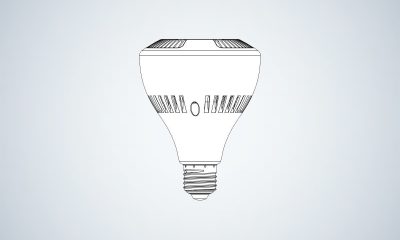What is a rechargeable light bulb
A rechargeable light bulb is an integral-base battery backup LED lamp that combines normal and emergency mode functionalities into a single assembly to provide both normal and emergency lighting. When unscrewed from the socket, the self-contained lamp can be carried around to function as a portable flashlight or lantern. In the event of a power outage, the LED bulb switches to emergency mode and operates the LED load for a minimum of 90 minutes. Some products can provide an emergency duration of up to 6 hours when they are operated at a reduced power level.
Rechargeable light bulbs make a great addition to residential backup lighting which reduces the likelihood of panic, facilitates egress and protects life safety. Their plug-and-play simplicity enables hassle-free conversion of table lamps, floor lamps, wall sconces, ceiling lights or any lamp-based fixtures into dependable emergency lighting systems.
Types of rechargeable light bulbs
Rechargeable light bulbs are mostly available as A-shape (“Arbitrary”) or general service bulbs of larger sizes (A19, A21). They may also take the form of BR (bulged reflector, BR30, BR40) bulbs, PAR (parabolic aluminized reflector, PAR30, PAR38) bulbs, or bulbs in other shape and size designations. These integrated LED lamps are comprised of an LED module, a rechargeable battery, a heat sink, driver and control circuitry, a medium screw base or bayonet base, and other optical and mechanical components. The LED module is an SMD LED assembly which is made up of an array of discrete LED packages populated on a metal-core PCB, with additional thermal, mechanical and electrical interfaces. The SMD LEDs are usually mid-power polymer-based packages that evolved from the plastic leaded chip carrier (PLCC) type of electronic packages. By embedding the LED dies in a reflective cavity, these semiconductor emitters deliver the highest photon extraction efficiency and consequently the highest luminous efficacy among all package platforms. The use of high efficacy light sources minimizes the drain on the battery and maximizes run time on a single charge. The heat sink serves to effectively dissipate heat generated from the LEDs, allowing the critical LED and battery temperatures to be maintained at all times within the specified limits.
Driver and control circuitry
In the presence of normal AC power, the LEDs are powered by an AC-DC LED driver. A typical AC-DC LED driver is a switch mode power supply (SMPS) which uses switching power conversion to transform the incoming AC line power into the regulated DC output current. The constant current LED driver must not only operate efficiently and reliably but also generate minimal output current ripple such that the LEDs do not flicker. When normal AC power is lost, the switching circuitry will detect this condition and automatically switch to emergency mode. In some products, however, the switch is manually made. In the emergency mode, energy stored in the rechargeable battery is converted to DC voltage and current necessary to drive the LED load. Upon restoration of AC power, the switching circuitry will connect the LED load back to the mains-powered LED driver and the battery automatically returns to the charging mode. Rechargeable light bulbs can be solar powered or recharged through a USB connection from a computer.
Rechargeable battery
The proper function of a rechargeable light bulb not only depends on the driver and control circuitry but, to a great extent, on the performance of the batteries used. Lithium-ion technology is the universal choice for electrochemical energy storage in light bulbs. Lithium-ion batteries have the highest energy density of all battery chemistries. This advantage affords the LED lamp a long run time and a reduction in the space necessary for the battery. This type of battery has significantly longer cycle life than NiMH and other types of rechargeable battery in deep discharge applications. Lithium-ion batteries are also known for their high charging efficiency and low self-discharge rate. One disadvantage, however, is safety. A battery management system (BMS) must be used to keep the electrochemical cells within a safe operating range during charge and discharge.



















Loading...